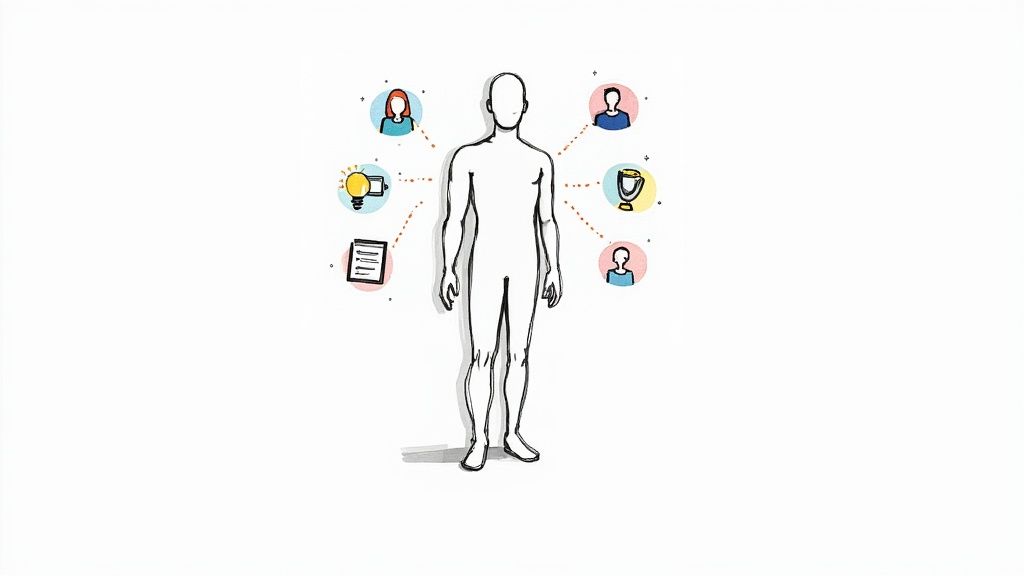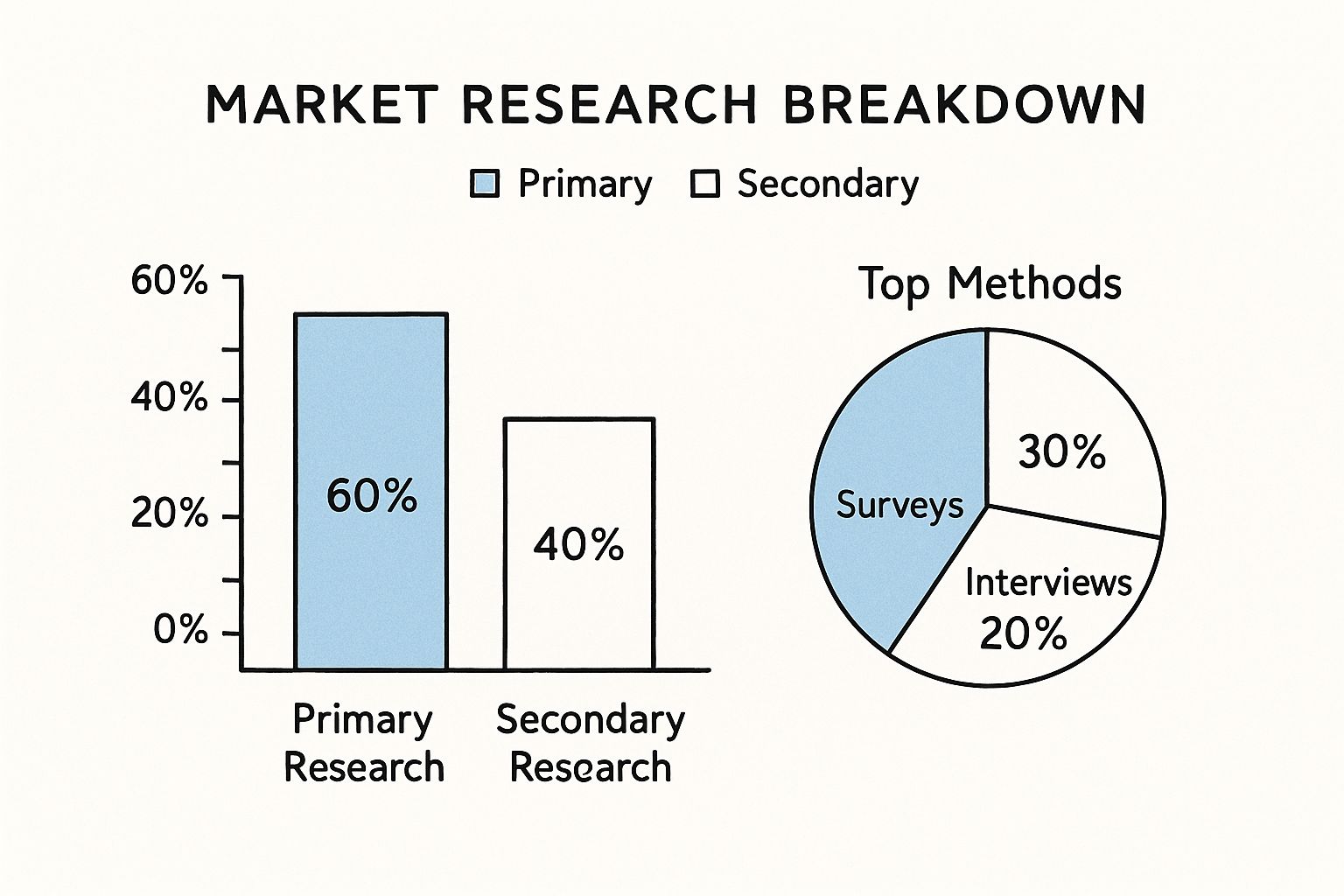Trying to market to everyone is like shouting into a void. You might make a lot of noise, but is anyone actually listening? This is why creating buyer personas isn't just another box to check on your marketing to-do list—it's the foundational first step. It’s how you stop broadcasting and start having real conversations with people who genuinely need what you're selling.
Why Generic Marketing Misses the Mark

Think about the last time a totally random ad popped up in your social feed. You probably scrolled right past it without a second thought, right? That's the fate of most generic marketing—it just becomes part of the background noise.
When you cast a wide, undefined net, your message gets watered down. It’s bland. It lacks the sharp, specific hook needed to grab someone's attention and make them feel like you get them. This approach is a fast track to wasted ad spend, dismal engagement rates, and campaigns that never really get off the ground.
The Real Cost of a Wide Net
Plenty of companies have torched their marketing budgets by targeting the wrong crowd. Picture a high-end B2B software company blowing thousands on ads aimed at college students who have neither the budget nor the business need for their tool. They might get some clicks, but the conversions will be nonexistent.
This isn't just about being inefficient. It's about squandered opportunity. Every dollar you spend talking to an uninterested audience is a dollar you could have spent building a relationship with a future loyal customer.
At its core, the problem with generic marketing is that it ignores a fundamental human desire: we all want to feel seen and understood. A buyer persona is your roadmap to making that connection happen.
This is exactly why figuring out how to create buyer personas is so important. When you define who your ideal customer is—their goals, their daily frustrations, their motivations—you can craft marketing that actually connects on a human level. You stop pushing a product and start offering a solution.
The Proof Is in the Numbers
This isn't just a hunch; the data tells the same story. Marketing built on solid personas makes websites 2 to 5 times more effective because you're speaking directly to the right people. Content tailored for specific personas can boost customer engagement by as much as sixfold.
And in email marketing? The results are even more dramatic. Personalized campaigns using personas see a 14% higher click-through rate, a 10% higher conversion rate, and can generate 18 times more revenue than generic email blasts.
To really get this right, you have to commit to smart data-driven marketing strategies, as this data is what breathes life into your personas. It's all about building a foundation of deep customer understanding.
This guide will walk you through the whole process, step-by-step, so you can build personas that sharpen your cold email outreach and completely change your results.
Finding the Truth in Your Customer Data
Assumptions are the fastest way to create useless buyer personas. Seriously. If you want to build profiles that actually sharpen your cold outreach, you have to ground them in reality, not guesswork. This means digging into the raw data to see what your customers truly think, want, and do.
The good news? You're probably already sitting on a mountain of this information. The real challenge is knowing where to look and how to connect the dots. Time to put on your detective hat and start gathering the clues that will bring your personas to life.
Uncovering Insights Through Customer Interviews
Surveys are fine, but they only scratch the surface. If you really want to get to the heart of what motivates your customers, nothing beats a direct conversation. A single, well-conducted customer interview can reveal "aha" moments you'd never find in a multiple-choice questionnaire.
The goal here isn't just to ask what they think of your product; it's to understand their entire world. Use open-ended questions that get them telling stories.
- "Can you walk me through a typical day in your role?"
- "What was going on in your business that made you start looking for a solution like ours in the first place?"
- "What does a big win look like for you in the next six months?"
Listen for recurring themes, specific slang they use to describe their problems, and the emotions behind their words. These qualitative details are pure gold when you're trying to build a persona that feels like a real person.
Digging into Your Digital Footprints
While interviews give you the "why," your analytics platforms deliver the "what." Tools like Google Analytics hold a treasure trove of quantitative data about how people actually behave on your website. This is where you can confirm or challenge the stories you hear in interviews with hard evidence.
For example, your analytics can show you the exact journey people take from their first visit to making a purchase. You can segment audiences by demographics or geography and spot patterns. Maybe you notice that VPs of Sales from the tech industry almost always view two specific case studies right before requesting a demo. That’s a powerful insight.

From a dashboard like this, you can quickly see the age, gender, and location of your most engaged visitors. It’s a simple but solid starting point for the demographic foundation of your personas.
Listening to the Voice of the Customer
Your sales and customer support teams are on the front lines every single day. They have a direct, unfiltered line into your audience's biggest questions, objections, and frustrations. Tapping into this resource is absolutely non-negotiable for building accurate personas.
Set aside time to listen to recorded sales calls or shadow a few customer support conversations. Pay close attention to:
- Initial Objections: What are the very first hurdles or skeptical comments prospects bring up?
- Feature Questions: Which parts of your product or service do they get hung up on? What's confusing?
- Pain Point Language: How exactly do they describe the problems they're trying to solve?
Capturing the exact words your customers use is incredibly powerful. When your marketing materials and cold emails reflect their own language back to them, it creates an instant connection and builds trust.
This direct feedback ensures your personas are based on real-world interactions, not just your internal team's assumptions about what customers care about.
Organizing Your Research for Clarity
At this point, you'll have a mix of spreadsheets, interview notes, and call transcripts. The next crucial step is to organize all this information so you can start seeing the patterns that will define your personas.
Create a central document—a spreadsheet works well—to consolidate everything you've found. Start looking for common threads that connect different data points.
- Does a specific job title consistently mention the same business challenge?
- Does a certain demographic group always visit the same three pages on your site before bouncing?
- Are prospects on sales calls using the same terminology you're seeing people use on social media?
This process is all about triangulation—confirming a finding from multiple sources. It’s what gives your personas their strength and reliability. By combining what people say (interviews), what they do (analytics), and what they ask (sales calls), you build a rich, multi-dimensional view of your ideal customer.
These deep insights are fundamental for developing powerful messaging, which is a key component of what we explore in our guide to AI email personalization.
To get a clearer picture of these methods, it helps to compare them side-by-side. Each source has its strengths and weaknesses, and a blended approach is always best for a complete view.
Effective Data Sources for Persona Creation
Ultimately, no single source tells the whole story. By pulling from interviews, analytics, and your internal teams, you get a much more reliable and actionable picture of who you're actually selling to.
Connecting the Dots in Your Research

Let's be real—raw data is just a pile of facts. A spreadsheet full of numbers and a doc overflowing with interview quotes don't mean much on their own. The real work begins when you start connecting those isolated data points to find the human story hiding inside.
This is the phase where you turn chaos into clarity. It's how a mountain of information gets whittled down into a handful of distinct, usable customer archetypes. Think of yourself as a detective looking for clues: recurring themes, shared frustrations, and common goals that tie different people together.
From Raw Data to Actionable Insights
First things first, get all your research into one place. I don't care if you use a spreadsheet, a digital whiteboard like Miro, or old-school sticky notes on a wall. The goal is to see everything at once.
This is where you can start grouping similar ideas together, a technique called affinity mapping. It's a surprisingly simple but powerful way to watch clusters of information emerge from the noise.
For example, you could set up columns for your interview questions and rows for each person you spoke with. As you fill it in, you'll physically see patterns taking shape. Did five out of your eight interviewees mention feeling swamped by "manual data entry"? That’s a huge clue.
Your goal isn't to document every single data point. It's to find the themes and emotional drivers that are repeated most often. These repetitions are the building blocks of your personas.
By clustering these common threads, the skeletons of your personas begin to appear. One group might be all about efficiency and saving time. Another might be laser-focused on getting better data for their reports. These core motivations are what will eventually separate one persona from another.
A Real-World Example in Action
I was once helping a SaaS company that couldn't quite nail down who their ideal customer was. We ran about a dozen interviews with new customers, and a small, almost insignificant detail kept popping up. Nearly half of them mentioned having to present reports to their "non-technical CEO" every Friday afternoon.
On its own, this isn't earth-shattering. But as a recurring theme, it became the cornerstone for a new buyer persona we called "Reporting Rachel."
- Her core pain point wasn't just creating reports; it was the gut-wrenching stress of having to translate complex data for a boss who didn't get the jargon.
- Her goal wasn't just to do her job; it was to look competent and prepared in those high-stakes Friday meetings.
- Her "Aha!" moment was realizing our tool's automated, visually simple dashboards could do the translating for her.
This one insight changed everything. We immediately shifted our messaging from generic stuff like "powerful analytics" to "create CEO-ready reports in minutes." The cold email campaign we built around that new angle, targeted specifically at people with similar job titles, was one of their most successful ever. It's a perfect example of how one small, repeated detail can unlock a powerful story.
Identifying Your Core Persona Groups
As you sift through your findings, you should aim to identify 3-5 distinct persona profiles. Any more than that, and your marketing gets diluted and confusing. Any fewer, and you’re probably oversimplifying your audience and missing key nuances.
Look for the clear dividing lines in your data. What are the key differentiators that create separate groups?
- Job Role and Responsibilities: A manager's daily grind is completely different from a specialist on their team.
- Company Size: The founder of a 10-person startup has wildly different buying criteria than a department head at a 500-person corporation.
- Primary Goals: Is their main driver saving money, boosting revenue, or just cutting down on mind-numbing manual work?
- Technical Proficiency: Are they a power user who loves new software, or someone who gets anxious just thinking about a new tool?
These categories will help you slice up your research and build out profiles that are actually distinct from one another. Each persona should represent a significant slice of your target market and have a unique set of problems your product solves.
This kind of segmentation is also a game-changer for better prospect qualification, something we dive into in our guide to effective lead scoring. Once you have these groups defined, you're ready to start fleshing them out into real characters.
Building Personas That Feel Real
Okay, you've waded through the research and spotted the patterns. Now for the fun part. This is where you take all those data clusters, interview notes, and analytics reports and breathe life into them, creating a character that feels like someone your team could actually grab a coffee with.
A great persona isn't just a document; it's a story. You’re building a narrative around a real person's professional life, digging into what drives them and what keeps them up at night. This is the make-or-break step that turns a generic, useless profile into a powerful tool that sharpens your entire outreach strategy.
Give Your Persona a Name and a Face
First things first, give your persona a name. It sounds almost silly, but it works. Alliterative names like "Marketing Manager Molly" or "Startup Steve" are sticky and easy for everyone on the team to remember and talk about.
Next up, find a stock photo. Putting a face to the name is a small but mighty psychological hack. It makes the persona instantly more human and keeps them from becoming just another abstract concept buried in a slide deck.
A persona without a name and a face is just a list of data points. Add these simple human touches, and you create a tangible character your sales and marketing teams can actually visualize and connect with.
Remember, you're not writing fiction here. You're building a composite sketch based on the dozens of real people you've researched. Every single detail should tie back to a pattern you uncovered earlier.
Flesh Out Their Story
With a name and face in place, it’s time to build out their world. Move beyond basic demographics and get into the psychographics—the why behind what they do. Paint a picture of their typical day.
- What’s the very first thing they check when they get to their desk?
- What software tabs are permanently open on their browser?
- Who do they report to, and what kind of heat are they feeling from above?
- What does a “win” for the week actually look like for them?
Your research holds the answers. If you heard three different interviewees complain about manually wrestling with spreadsheets for their weekly reports, that becomes a core frustration for your persona. If your site analytics show a blog post about getting budget approval is a top performer, that tells you a lot about their professional hurdles.
Essential Components of a Persona Document
So, what should the final document actually include? To make a persona truly actionable for your team, you need to break it down into specific, concrete components. Vague descriptions like "is busy" or "wants more leads" just don't cut it. You need the nitty-gritty details.
This table outlines the key pieces of information that make a persona profile genuinely useful.
Putting this level of detail into your personas is what makes them practical. When your copywriter sits down to draft an email, they'll know exactly which pain point to hit. When your product team is brainstorming, they can ask, "Would this really help Rachel solve her Friday reporting nightmare?"
A Tale of Two Personas: From Vague to Valuable
Let’s look at the difference this detail makes in the real world. Here’s a weak, generic persona that many companies unfortunately use.
The Generic Persona: "Marketer"
- Works in a marketing department
- Goal is to increase leads
- Challenges: is busy
- Uses social media for work
This is basically useless. It describes almost every marketer on the planet and gives your team absolutely nothing to work with. Now, compare that to a persona built from solid research.
The Detailed Persona: "Reporting Rachel"
- Role: Marketing Operations Manager at a mid-sized B2B tech company (200-500 employees).
- Goals: Automate her weekly reporting workflow to reclaim 5-8 hours per week; create visually simple dashboards for a non-technical leadership team.
- Challenges: She dreads the "soul-crushing" task of manually exporting CSVs from three different platforms every Friday morning. She feels a constant low-grade anxiety that her CEO will ask a question she can't answer on the spot.
- "Aha!" Moment: Realizing a tool could do more than just automate the data pulls—it could also translate the complex metrics into simple, CEO-friendly visuals.
See the difference? You can practically feel Rachel's Friday afternoon stress. That specificity gives your team a crystal-clear target. You know her exact pain points, the emotional language she uses ("soul-crushing"), and the precise solution she's looking for. This is how you craft messaging that actually connects.
Building personas this way is one of the most critical lead generation best practices because it ensures every single piece of outreach is relevant. It’s the foundation for shifting from shouting into the void to having strategic, effective conversations.
Putting Your Personas to Work
Creating detailed buyer personas is a huge step, but the job isn't finished. Let's be honest, a persona profile gathering digital dust in a shared drive is completely worthless.
The real value gets unlocked when you actually put these insights into action. This is where you transform a research document into a practical tool that sharpens every single piece of your outreach.
This is where your hard work starts paying dividends. It's time to make your marketing smarter, more targeted, and a hell of a lot more effective.

From Persona Profile to Personalized Outreach
Once you have a crystal-clear picture of who you're talking to, you can start tailoring your communication with incredible precision. This goes way beyond just slotting a prospect's {firstName} into an email template.
It’s about speaking directly to their specific context and challenges.
For instance, a cold email to "Reporting Rachel" should never lead with generic benefits. Instead, try a subject line that hits home: "An idea for your Friday CEO reports." That immediately signals you understand a specific pain point in her work week.
From there, the body of the email can dive straight into her frustration with manual data entry and offer a clear, relevant solution. This targeted approach completely changes the game. You're no longer sending one generic message to 1,000 people; you're sending a highly relevant message that feels like it was written just for them.
The most effective marketing doesn't feel like marketing at all. It feels like a helpful conversation. Your personas are the cheat sheet for starting that conversation on the right foot, every single time.
Aligning Your Entire Organization
For personas to truly work, they can't live in a marketing silo. Their power multiplies when they are shared and adopted across your entire organization.
When sales, marketing, and product teams all have a unified vision of the customer, amazing things start to happen.
- Sales Teams: Can use persona insights to anticipate objections and tailor their pitches to what truly matters. They’ll know whether to focus on ROI, ease of use, or security features.
- Marketing Teams: Can brainstorm blog topics that solve real problems, write ad copy that actually resonates, and create content that attracts the right audience from the start.
- Product Teams: Can use personas as a north star for feature development, constantly asking, "Would this new feature genuinely help 'Startup Steve' achieve his goals?"
This shared understanding ensures a consistent customer experience at every touchpoint. The language in your ads matches the language on a sales call, which aligns perfectly with the user experience inside your product.
Personas Are Living Documents
The market changes. Your product evolves. Customer needs shift. Because of this, your buyer personas should never be treated as a "one and done" project.
Think of them as a dynamic guide, not a static rulebook. They need regular check-ups to stay relevant and effective.
Set a simple review cycle—maybe once every six to twelve months—to check in. Are they still accurate? Have new challenges emerged for your audience? Has your ideal customer profile shifted at all?
This commitment to keeping your personas current has a direct, measurable impact. Research shows that a whopping 90% of companies using personas report a better understanding of their customers.
Even better, over 60% of companies that updated their personas within the last six months successfully surpassed their lead and revenue targets. This stuff works.
Ultimately, figuring out how to create buyer personas is only half the battle. Actively using and maintaining them is what separates companies with a nice research project from those with a powerful tool for growth.
When you use personas to guide every decision—from a single email subject line to your overall product strategy—you build a smarter, more customer-centric business. For a deeper dive into the foundational elements, check out our guide on creating a powerful customer avatar.
Got Questions About Buyer Personas? We've Got Answers.
Even with the best game plan, you're bound to run into a few questions when you start building out buyer personas. It’s completely normal. Let's walk through some of the most common sticking points to make sure you're building a tool that will actually sharpen your outreach.
How Many Buyer Personas Should We Create?
There’s no magic number here, but I've found that most businesses hit the sweet spot with 3 to 5 core personas.
If you try to create a dozen right out of the gate, you'll spread your efforts too thin and end up with a bunch of vague, useless profiles. Start with your most common and profitable customer types—the ones you know inside and out. The goal is depth, not breadth.
Focus on a few incredibly detailed and distinct personas. You can always add more down the line as you expand into new markets or roll out new products. It's all about quality over quantity.
What Is the Difference Between a Buyer Persona and a Target Audience?
This is a big one, and the distinction is crucial.
Your target audience is the wide-angle view. It's a broad description of a group defined by demographics—think age, industry, or location. For example, "male marketing managers, 30-45, in the tech sector." It’s a good starting point, but it's pretty generic.
A buyer persona zooms in on a single, semi-fictional character from that audience. It's where you add the color and the story. It digs into their motivations, what keeps them up at night, their career goals, and the daily frustrations they face. It turns the "who" into the "why."
Think of it like this: a target audience tells you what kind of people you're marketing to. A buyer persona helps you understand what it's like to be one of those people. That empathy is your secret weapon for writing messages that actually land.
How Often Should We Update Our Personas?
Your personas aren't a "set it and forget it" project. They're living documents that need to evolve right alongside your business and your customers.
Markets change. Customer needs shift. Your product gets better. A good rule of thumb is to give your personas a solid review at least once a year to make sure they still hold up.
You'll also want to pull them out for a refresh whenever something big happens, like:
- You launch a major new product line.
- You start selling into a new industry or region.
- You notice a major shift in customer feedback or buying behavior.
Should We Create a Negative Persona?
Yes! This is one of the most underrated but powerful exercises you can do.
A negative persona (sometimes called an "exclusionary persona") is a detailed profile of the customer you absolutely don't want. This could be someone who always churns, costs a fortune to acquire, or is just a terrible fit for what you offer.
Clearly defining who you are not selling to is just as important as defining who you are. It saves you an incredible amount of time and money by helping you disqualify leads early on, which is absolutely vital for making your outreach efficient. It also helps you find company email addresses fast for the right people, not the time-wasters.
Ready to put your personas to work? PlusVibe uses AI to turn your customer insights into hyper-personalized cold email campaigns that get replies. Scale your outreach and connect with your ideal customers today. Learn more at PlusVibe.














































.jpeg)


.png)























































